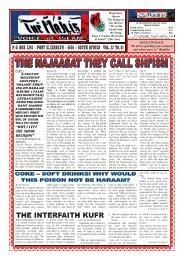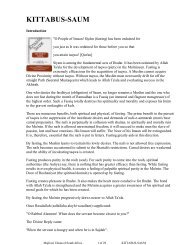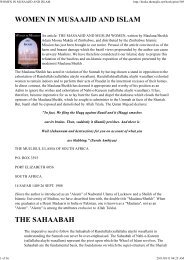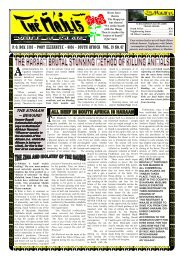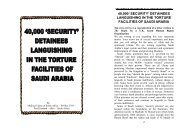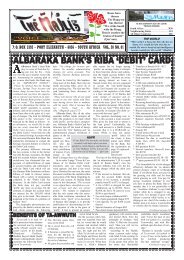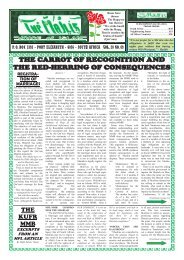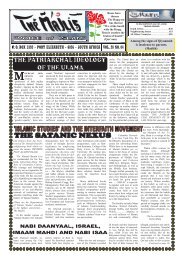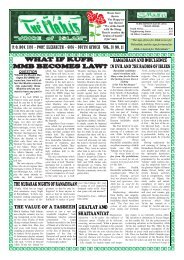DRESS ACCORDING TO THE SUNNAH - The Majlis
DRESS ACCORDING TO THE SUNNAH - The Majlis
DRESS ACCORDING TO THE SUNNAH - The Majlis
- No tags were found...
You also want an ePaper? Increase the reach of your titles
YUMPU automatically turns print PDFs into web optimized ePapers that Google loves.
<strong>DRESS</strong> <strong>ACCORDING</strong> <strong>TO</strong> <strong>THE</strong> <strong>SUNNAH</strong>(emulating the kuffaar) is an evil with far reaching effect on the heart of aMuslim. Hence, Rasulullah (sallallahu alayhi wasallam) said:"Whoever emulates a people becomes of them."In this article we propose to discuss one particular aspect of Islamicdressing, viz., headgear. In these times of intense ,kufr and dhalaal, whenmany Muslims have sacrificed their intelligence to become slaves ofwestern culture, there is a great desire among modernists to abandonthe wearing of Islamic headgear. Among the styles of Islamic headgear isthe popular topee which innumerable millions of Muslims have donnedover the past centuries of Islamic history. Now in this belated centurymodernists are at pains to discard this compulsory dress-style of Islam.Fallacious arguments are fabricated to deceive innocent and unwarypeople into accepting that the topee or Islamic headgear has norelevance in the Shariah.It should be understood that the ways and styles of Islam did notoriginate from dubious sources nor were its originators non-entities asare the votaries of western styles. Furthermore, Islamic dress-styles wereinherited by the Ummah from generation to generation. Each successivegeneration obtained its Islamic dress-style from its preceding generation.In this way the chain links up with the Sahaabah who disseminatednothing other than the Sunnah of Rasulullah (sallallahu alayhi wasallam).Headgear in Islam is not a new development <strong>The</strong> villifier of the topi mustpresent his proof toindicate the point in time in Islamic history when thisheadgear became an accredited Islamic head-dress. If he contends thatthe topi has no Islamic relevance, let him prove his case with Islamic factsand Shar'i proofs. <strong>The</strong> assertion that many people presently in the MiddleEast pray without headgear is not Shar'i evidence for the fallacy that thetopi has no Islamic status. What is presently being perpetrated in Muslimcountries cannot becited as Islamic evidence for a claim. Only anignoramus who suffers from colossal ignorance will advance such puerileand ludicrous 'proof for hisclaim. When the weight of Islamic practice ofthe past fourteen hundred years upholds Islamic headgear as an integraland incumbent part of a Muslim's chess, then by what stretch of17<strong>DRESS</strong> <strong>ACCORDING</strong> <strong>TO</strong> <strong>THE</strong> <strong>SUNNAH</strong>intelligent reasoning can any Muslim decry and villify such head-dress?When all the illustrious authorities of Islam from the time of the ahaabahemphasised the donning of headgear, not only for Salaat, but at all times,then it is only necessary to dismiss with contempt the arguments againstthe topi blustered out by the enemies of the Sunnah of Rasulullah(sallallahu alayhi wasallam).<strong>The</strong> topi is the head-dress which distinguishes a Muslim from a non-Muslim. <strong>The</strong> importance of this headgear is amply illustrated by thefollowing command of Rasulullah (sallallahu alayhi wasallam):"<strong>The</strong>difference between us and the mushrikeen is turbans on top of qalaanis(topis)."Even mushrikeen were in the habit of donning turbans. Rasulullah(sallallahu alayhi wasallam) detested resemblance with them. Emulatingnon-Muslims is forbidden by Islam, hence Rasulullah (sallallahu alayhiwasallam) ordered that Muslims wear topis under their turbans eventhough the topis are totally concealed and not visible from under theturbans. Even the style of headgear which the Muslim adopts should notresemble the head-dress of the kuffaar, hence Shaikhul Islam Zakariyya(rahmatullah alayh) states:"In our time it is not permissible to wear green and yellow turbans"(Husnus Siyar of Dimyaati Shaafi).Since green and yellow turbans were among the particular dress-styles ofthe Yahood and Nasaara of that time, the authorities of the Shariahbanned the wearing of such turbans so that Muslims do not violate theShar'I prohibition of emulating kuffaar. <strong>The</strong> following verdict appears inFataawa Khaazin and Fataawa Hindiyah:"A man will be proclaimed a kaafir for adopting the head-dress of theMajoos (fire-worshippers)."<strong>The</strong> following verdict appears in the famous Maaliki Kitaab, MukhtasarulKhaleel:18



